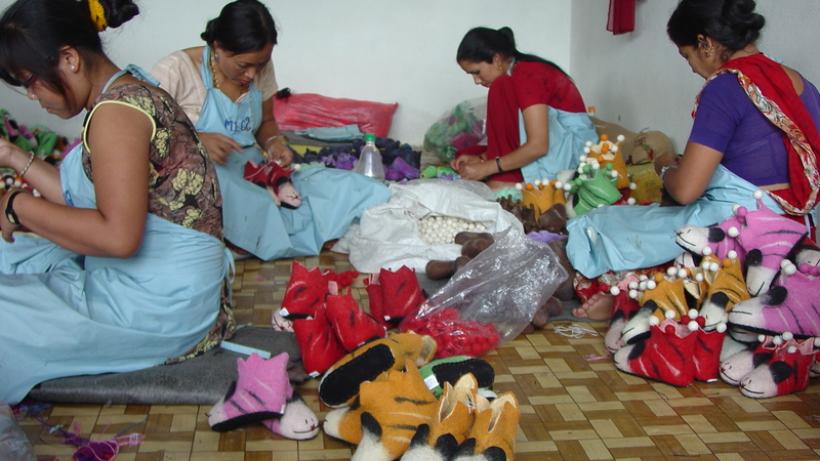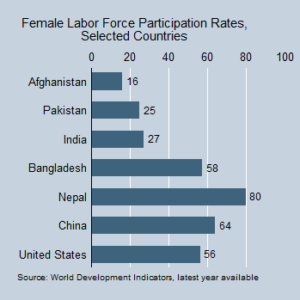
Women’s economic opportunities: What can South Asian countries learn from each other?
When women make their own money – or even when they have the option to work for a fair wage – their health, power in the domestic sphere, and position in society all improve, and parents begin to invest more in the health and education of their daughters.
A wide range of research from South Asia and across the world has shown this.
For example, a study in India found that the availability of jobs in call centres led girls to spend more years in school and delay marriage and child-bearing. A study in Bangladesh found similar effects from the availability of work in the garment industry. Delaying family life brings its own benefits: women face less domestic violence when they marry later, and fewer health risks when they bear children later. Households with a women earner invest more in children of either gender.
 Figure 1: Female labor force participation rates, selected countries
Figure 1: Female labor force participation rates, selected countries
So raising the rate of female labour force participation (FLFP) is a policy goal for South Asian governments. This rate varies greatly across the region, from 16% in Afghanistan to 80% in Nepal.
Why such a wide range? One explanation was put forward by Harvard economist Claudia Goldin in a 1986 article and has been refined and contradicted by scholars ever since: broadly speaking, FLFP follows the U-shaped curve you can see in the graph below – high in very poor economies, then dipping in the lower-middle and middle-income ones, only to rise again in rich economies.
The logic is this: at low levels of economic development, poverty leads women and men alike to work low-wage jobs, particularly in agriculture. As an economy grows, men become more educated, get better jobs, and bring more money home. Perhaps in such situations, women favour staying at home over getting non-agricultural jobs that are relatively low-paying, or perhaps women, whose education has historically lagged behind men’s, come second to men in accessing these jobs. At more advanced stages of development, average household income continues to rise – and with it the education women attain and quality of jobs they can win.
Critics of this model point out that India is not following the U-shape trend. There, FLFP remains low despite growth, and is actually continuing to descend even as women make great gains in educational attainment.
 Figure 2: Log GNI per capita (2013)
Figure 2: Log GNI per capita (2013)
Furthermore, it’s important to point out that the dip in the U-shaped path is avoidable. In Bangladesh, two simultaneous movements led to economic opportunities for women outside agriculture: the growth of the garment sector in cities and the expansion in non-agricultural home-based work for rural women, attributed in part to the microfinance revolution.
Still, the U-shaped curve gives us a rough framework to spot the opportunities and dangers that South Asian women face as their work-related choices expand. Nepal’s FLFP rate reflects high poverty: 84% of Nepalese working women are employed in agriculture, and fully half of those women are either the main breadwinner or an important source of income for their households. The limited economic opportunities outside of agriculture leads to large migration for labour: 28% of the country’s GDP in 2014 came from workers sending money home from abroad.
But as Nepal’s policymakers work to create jobs for women, they must make sure they are the right kind of jobs. In India, where many types of employment are closed to women, the manufacturing sector has been relatively open. Yet an analysis that our Harvard-based research group Evidence for Policy Design (EPoD) conducted for a government skills-training program in India showed the gender gap in wages is much wider in manufacturing than in other industries. Men make twice as much as women in factory jobs, but only 5% more in the services industry. In this case, the role of policy is to either prepare women for the equitable sector, or to try to equalize wages.
In Pakistan, we see that women are constrained by their own and their families’ ideas of what constitutes “suitable” employment. Few women who aren’t working say they are available for work or actively seeking work. But 40% of women who are not employed say they did not have enough to do in the previous day, and when instead asked, “would you work if you could find a suitable job?” around a quarter say yes. A paper on FLFP in Pakistan calculated that if these women worked, the country’s rate would double. The authors concluded, “If few socially acceptable jobs are available, women will earn lower wages or simply not take up work at all.”
In Afghanistan, ideas of the suitability of work are compounded by security concerns: a study found that FLFP is negatively correlated with the incidence of violence. Yet a recent survey found that three-quarters of Afghani women believe that women should be allowed to work outside the home.
Our point is not to undermine women who work for low wages – or for no wages. Women’s unpaid work, particularly in raising and protecting their children, has built the world as we know it. Rather, our point is that cross-country comparisons can illuminate ways to prevent exploitation, as well as opportunities for women to access the kind of power and self-determination that a job can bring.
On 23–24 March, EPoD is bringing together women leaders from all of the countries mentioned above to discuss these opportunities with international researchers. The event, Smart Policy for Women’s Economic Empowerment, is supported by UK Aid from the UK Government through the BCURE Programme, the IGC, and the Kennedy School Women and Public Policy Program.
For more about FLFP and women’s empowerment, read Ideas for India’s recent #WomenAndWork e-symposium, and stay tuned: we will be posting on Ideas from India after this week’s events in Kathmandu to describe the research and real-world solutions that came to light.

